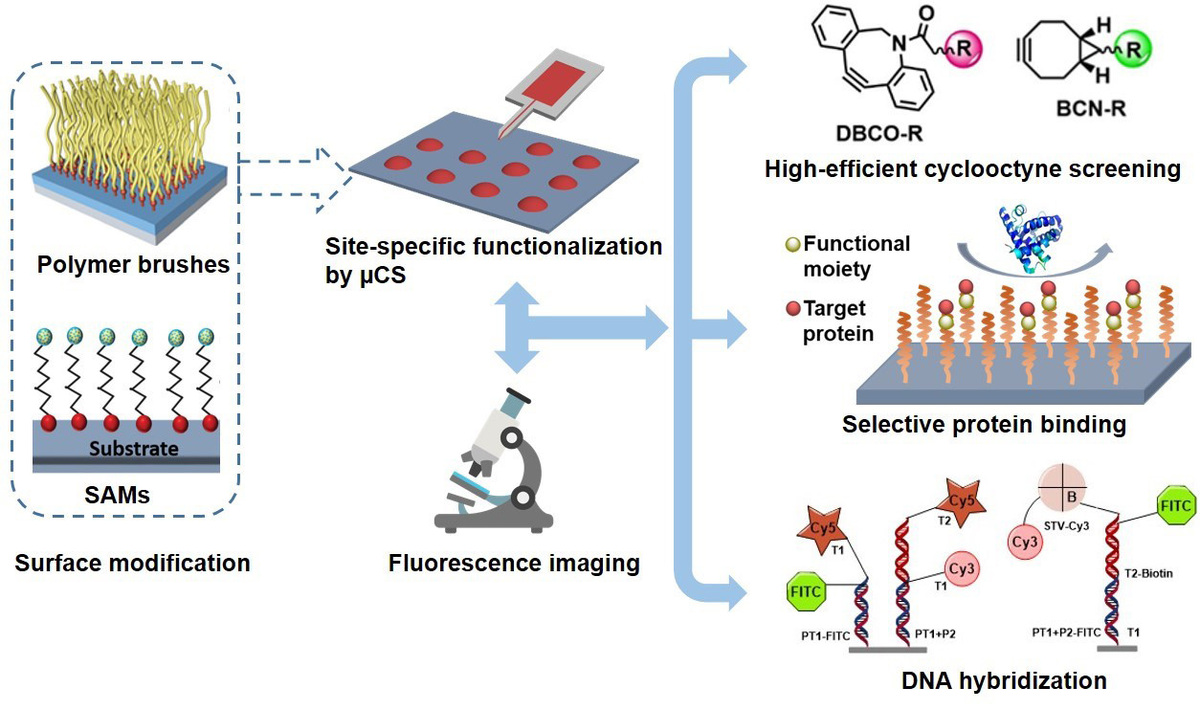
Functionalization of brush-like Polymer modified Surfaces by Scanning Probe Lithography for biological Screening Applications
-
Author:
Bingquan Yang
-
Source:
Dissertation, Karlsruher Institut für Technologie (KIT) (2022)
- Date: 2022
-
In this dissertation, different surface modification techniques are employed in combination with microchannel cantilever spotting (µCS) to design different biochips for bioscreening and biomedical applications. For these purposes, glass slides are modified with different functional moieties, e.g., self-assembled monolayer (SAM) of alkyne and polymer brushes bearing clickable reactive groups fabricated by “grafting to” or “grafting from” approaches. Furthermore, different inks are patterned to the chips via µCS, and different ink-substrate combinations (click reactions in between them) are demonstrated, as well as the bio-screening and bio-detection are evaluated by fluorescent imaging. To easily and conveniently evaluate the binding efficiency of cyclooctyne/azide, different derivatives of DBCO/BCN (dibenzocyclooctyne/bicyclononye) linked to either a fluorophore or a biotin-moiety are patterned on azide-bearing antifouling polymer brushes (AAPBs) via µCS. The AAPBs are composed of two building blocks, an antifouling bottom block, which can avoid unspecific protein contamination during incubation without any advancing blocking steps; and an azide functionalized top block, which can bind to alkynes via strain-promoted alkyne-azide cycloaddition (SPAAC) reactions. The assessments of binding efficiency are conducted on ordered arrays with a standard fluorescent microscope. Both cyclooctynes demonstrate reliable binding performance with azide moieties at µCS patterned area, but DBCO shows a higher surface density of molecular immobilization according to the protein binding assays. Herein, we provide a reference for choosing appropriate cyclooctyne to couple with azides that can be useful for the design of biosensors or bio-platforms. A novel and facile fluorescent immunosensor is designed by direct anchoring of antibodies for the determination of α-fetoprotein (AFP) for diagnosis of hepatocellular carcinoma (HCC). DBCO-NHS ester capture arrays, which are used for anchoring AFP-antibody through covalent amide bonds (direct binding strategy), are patterned on AAPBs by µCS. The DBCO-NHS ester arrays can mildly and efficiently bind to AAPBs via SPAAC reaction followed by grabbing anti-AFP via forming of amide bonds (HNS/amino) for detection of fluorescently labeled AFP specifically and directly. For comparison, DBCO-Biotin is spotted on AAPBs to construct sandwich structures (biotin/streptavidin/biotin-antibody) for AFP detection (indirect binding strategy). The results show that the direct and indirect strategies both work well for AFP detection, and also provide that the direct strategy (NHS/antibody/AFP) is more sensitive than the indirect strategy (biotin/streptavidin/biotin-antibody/AFP), which is perhaps benefitting from the compact fabrication process of the direct strategy. Overall, the proposed cost-effectively and reliably fluorescent immunosensor exhibits great potential in clinical and diagnostic applications for AFP detection. Diamond-related materials with auto-photoluminescence are an essential tool in the construction of bioprobes and biosensors in fluorescence imaging. However, the diamond interface is susceptible to contamination by biological media or macromolecules in complex samples or even living systems, thus impairing its emission of fluorescence and leading to a low signal-to-noise ratio, broadly limiting applications. A new protein-repellent and clickable reactive polymer brush is designed to abolish unspecific protein adhesion and enable immobilization of recognition-element and fluorophore-linked compounds. The polymer brushes have two different segments, an antifouling poly(N-(2-hydroxypropyl)-methacrylamide) (HPMA) segment and an alkyne terminated poly(propargylacrylamide) (AlkMA) segment providing the click-functionality. The antifouling properties and clickable reactivity of the polymer brushes are demonstrated with selective protein binding assays on micropatterns written by µCS. Significantly, the polymer brush is successfully attached on the diamond surface and efficiently inhibits protein pollution, improving the signal-to-noise ratio. In-vitro studies, gene editing and expression are highly dependent on DNA microchips, however, conventional chips require sophisticated and expensive manufacturing processes. The surface characteristics of DNA biochips generally affect the DNA hybridization behaviors. Therefore, three reactive substances possessing different surface topographies and compositions are involved in construction DNA sensing platforms, namely, gold-coated silicon, poly(bisphenol A-co-epichlorohydrin) (PBAG) grafting polymer, and SAM of DBCO-functionalized slides. Herein, DNA directed-immobilization (DDI) together with µCS offers a cheaper and more accessible way to construct DNA probe microarrays, which can be easily read out with a fluorescent microscope. All of these three platforms behave a reliable ability for DNA detection, but the PBAG-modified surface exhibits a higher hybridization efficiency either at a short probe (22mer) hybridized with a short target (22mer) system or at two short targets (both are 22mer) hybridized with a long probe sequence (44mer) system. The results have significant implications for better understanding of the interactions between the DNA hybridization efficiency and the surface properties of substrates and inform the fabrication of high-throughput DNA biosensors.
